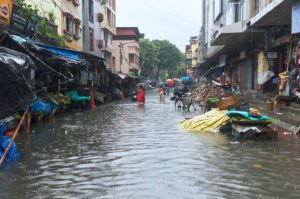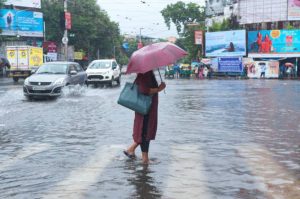Kolkata August Weather: Kolkata, the cultural capital of India, is no stranger to weather mood swings during August. This week, the city finds itself under the grip of a low-pressure system over the Bay of Bengal, promising intermittent showers yet delivering an unrelenting wall of humidity.
On Wednesday morning, many residents woke to overcast skies, gentle breezes, and the faint earthy scent of petrichor — a teaser for the rain that meteorologists predicted would visit in scattered spells throughout the day.
While the showers are expected to cool the city momentarily, experts warn that humidity levels may climb above 80%, leaving much of Kolkata sticky, restless, and reaching for ceiling fans even during the rain.

The Weather Setup: Science Behind the Showers
According to the India Meteorological Department (IMD), the present weather disturbance stems from a low-pressure area situated over the northwest Bay of Bengal, just off the Odisha–West Bengal coast. Such systems are common during August, forming when warm, moisture-laden air over the sea interacts with cooler atmospheric conditions.
This creates convective currents — vertical air movements that cause clouds to build rapidly, leading to intermittent rain. However, unlike a continuous monsoon downpour, these rain events are patchy, meaning some neighborhoods might get drenched while others remain dry within the same hour.
“Intermittent showers are characteristic of the monsoon’s mid-phase,” explained a senior IMD meteorologist from Alipore. “They provide relief from heat, but the trapped moisture under dense cloud cover often pushes humidity levels higher, especially in urban zones where concrete retains heat.”
Track real-time IMD rainfall maps here.
Kolkata August Weather: Temperature and Humidity Profile
The IMD forecast suggests that:
- Maximum temperature: 32–33°C
- Minimum temperature: 27°C
- Relative humidity: 80–85% in the morning, rising post-rain spells
These conditions mean perceived temperatures — what the body actually feels — can be 3–4°C higher due to the heat index effect. For instance, a recorded 32°C under 85% humidity can feel like 40°C to the human body.


Kolkata’s Long Affair with August Monsoon
Historically, August is the city’s second rainiest month after July. Data from the Regional Meteorological Centre shows that Kolkata receives an average of 330–350 mm of rainfall during August, contributing significantly to its seasonal monsoon quota.
However, the distribution is highly irregular. In some years — like 2015 and 2018 — August saw prolonged dry phases, leading to an agricultural deficit, while in others, such as 2020 and 2021, back-to-back low-pressure systems caused continuous rain and flooding.
One of the most memorable August events was in August 1978, when a series of heavy rain spells submerged large parts of central and north Kolkata for over a week, prompting major upgrades to the city’s drainage system.
Impact on Daily Life and Infrastructure
Transport and Commuting Challenges
Even moderate rain can cripple Kolkata’s already congested traffic network. The city’s colonial-era road layout, coupled with inadequate stormwater drainage in certain areas, makes it vulnerable to waterlogging.
Commuters on Wednesday reported early morning delays on EM Bypass, APC Road, and sections of Howrah Bridge due to slick roads and minor water pooling.
Auto-rickshaw and app-cab fares spiked by 20–30% during the first rain burst of the day. “Whenever there’s sudden rain, demand shoots up,” said Rajib Saha, an Uber driver in the Dharmatala area. “Many people avoid two-wheelers and prefer cabs, but the traffic slows us down.”
Markets and Street Vendors
The rain poses a daily gamble for open-air traders in Burrabazar, Hatibagan, and Gariahat. While umbrellas and tarpaulin sheets offer some protection, sudden wind gusts often blow water onto merchandise.
“Today I had to cover my stock three times since morning,” said Rehana Bibi, a street vendor selling clothes near Gariahat. “Sales drop during heavy rain hours because people don’t want to get wet, and by evening, the humidity makes customers impatient.”
Agriculture and Rural Ripple Effect
While the city focuses on traffic and wet clothes, rural West Bengal watches the rain forecast with more serious stakes. Farmers in South 24 Parganas, Hooghly, and Nadia districts rely heavily on August showers for aman paddy cultivation.
This year, rainfall in June and July was slightly below normal, leading to delayed sowing in some areas. The current low-pressure system could help compensate for the deficit if it lingers for a few more days.
“A steady spell of rain now will ensure healthy tillering in paddy plants,” said agricultural scientist Dr. Anupam Roy from Bidhan Chandra Krishi Viswavidyalaya. “But heavy, continuous downpours could also waterlog fields, so moderation is key.”
Public Health and Safety Advisory
Rainy and humid conditions can trigger spikes in vector-borne and waterborne diseases. The Kolkata Municipal Corporation (KMC) has warned residents to be cautious about dengue and malaria, as stagnant rainwater can become mosquito breeding grounds within 48 hours.
Preventive measures suggested by KMC:
- Emptying water from flowerpots, AC trays, and rooftop tanks every 48 hours
- Wearing long-sleeved clothing in mosquito-prone zones
- Drinking only boiled or filtered water
- Avoiding uncovered street food during the wet season
Meanwhile, doctors at Nil Ratan Sircar Medical College noted a rise in patients with viral fever and gastroenteritis over the past week. “The combination of humidity, wet clothes, and sudden temperature changes can weaken immunity,” said Dr. Rituparna Choudhury.
Kolkata vs. Other Eastern Cities This Week
Interestingly, the current low-pressure system is affecting weather patterns across eastern India. While Kolkata expects intermittent showers, cities like Bhubaneswar and Puri in Odisha are seeing heavier, more continuous rainfall. In contrast, Patna and Ranchi are experiencing only light drizzle.
This difference is due to the positioning of the low-pressure trough — Kolkata lies near its northern periphery, which causes shorter but more frequent rain events rather than prolonged spells.
Climate Change and Shifting Monsoon Patterns
Climate scientists warn that Kolkata’s monsoon is becoming increasingly erratic. A 2023 study by IIT Kharagpur found that while overall annual rainfall has not drastically reduced, the number of rainy days has declined, replaced by fewer but more intense downpours.
This shift increases the risk of urban flooding because the drainage system is better suited to handle gradual rain, not sudden cloudbursts delivering 100 mm in just a few hours.
Additionally, warmer sea-surface temperatures in the Bay of Bengal are leading to more frequent low-pressure formations, which can cause either excess rain or prolonged cloudy, humid spells.
Read the IIT Kharagpur monsoon variability study here.
Residents React: A City Divided Between Romance and Discomfort
For some Kolkatans, the rain brings a touch of poetry. Couples strolling in Victoria Memorial gardens under shared umbrellas, families sipping hot tea with pakoras, and young photographers chasing reflections in puddles — these scenes are as much a part of August as the rain itself.
But for others, it’s a season of laundry woes, disrupted commutes, and sticky afternoons. “I love the smell of rain, but I hate what it does to my hair,” laughed college student Ananya Basu, waiting for a bus near Esplanade.
Next 48 Hours and Beyond
The IMD predicts the low-pressure system will persist for at least the next two days, ensuring continued cloudiness and scattered showers. The weekend may bring heavier spells if the system deepens or moves inland.
In the meantime, the city’s best strategy is to stay prepared — keep umbrellas and raincoats handy, wear breathable fabrics to combat humidity, and allow extra travel time during peak hours.
Also read: Home | Channel 6 Network – Latest News, Breaking Updates: Politics, Business, Tech & More

